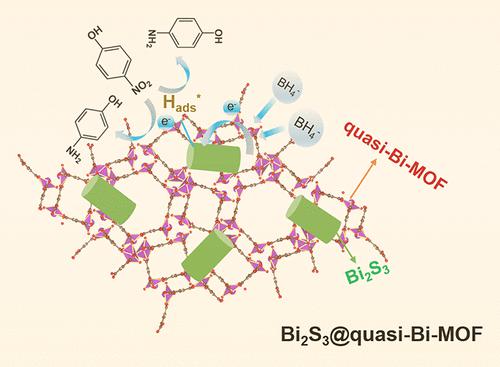当前位置:
X-MOL 学术
›
Inorg. Chem.
›
论文详情
Our official English website, www.x-mol.net, welcomes your
feedback! (Note: you will need to create a separate account there.)
In Situ Implantation of Bi2S3 Nanorods into Porous Quasi-Bi-MOF Architectures: Enabling Synergistic Dissociation of Borohydride for an Efficient and Fast Catalytic Reduction of 4-Nitrophenol
Inorganic Chemistry ( IF 4.3 ) Pub Date : 2022-12-01 , DOI: 10.1021/acs.inorgchem.2c03073 Jing Jiang 1 , Wei Wei 1 , Ying Tang 1 , Shiyu Yang 1 , Xinzhi Wang 1 , Ying Xu 1 , Lunhong Ai 1
Inorganic Chemistry ( IF 4.3 ) Pub Date : 2022-12-01 , DOI: 10.1021/acs.inorgchem.2c03073 Jing Jiang 1 , Wei Wei 1 , Ying Tang 1 , Shiyu Yang 1 , Xinzhi Wang 1 , Ying Xu 1 , Lunhong Ai 1
Affiliation

|
Catalytic hydrogenation reduction based on sodium borohydride (NaBH4) has gained attention as an appealing “one-stone-two-birds” approach for the simultaneous elimination of nitroaromatic pollutants and the production of high-value aminoaromatics under mild conditions. However, the slow kinetics of NaBH4 dissociation on the surface of catalysts restrict the catalytic hydrogenation reduction efficiency. Herein, we report an intelligent localized sulfidation strategy for an in situ implantation of Bi2S3 nanorods within quasi-Bi-MOF architectures (Bi2S3@quasi-Bi-MOF) by fine-tuning the pyrolysis temperature. In this novel Bi2S3@quasi-Bi-MOF, the porous quasi-Bi-MOF enables efficient adsorption of BH4– and 4-nitrophenol (4-NP), while Bi2S3 facilitates the BH4– dissociation to form Hads* species adsorbed on the catalyst surface. Benefiting from the synergistic structure, Bi2S3@quasi-Bi-MOF exhibits excellent performance for the catalytic reduction of 4-NP, delivering a high turnover frequency (TOF) of 1.67 × 10–4 mmol mg–1 min–1 and an extremely high normalized rate constant (knor) of 435298 s–1 g–1. The kinetic analysis and electrochemical tests indicate that this catalytic hydrogenation reduction follows the Langmuir–Hinshelwood mechanism. This study enriches the synthetic strategy of MOF-based derivatives and offers a new catalytic platform for hydrogenation reduction reactions.
中文翻译:

将 Bi2S3 纳米棒原位植入多孔准双 MOF 结构中:实现硼氢化物的协同解离以高效快速地催化还原 4-硝基苯酚
基于硼氢化钠 (NaBH 4 ) 的催化加氢还原作为一种吸引人的“一石二鸟”方法而受到关注,该方法可在温和条件下同时消除硝基芳烃污染物并生产高价值的氨基芳烃。然而,NaBH 4在催化剂表面解离的缓慢动力学限制了催化加氢还原效率。在此,我们报告了一种通过微调热解温度在准 Bi-MOF 架构(Bi 2 S 3 @quasi-Bi-MOF)中原位植入 Bi 2 S 3纳米棒的智能局部硫化策略。在这部小说中 Bi 2 S 3@quasi-Bi-MOF,多孔的quasi-Bi-MOF能够有效吸附BH 4 -和4-硝基苯酚(4-NP),而Bi 2 S 3促进BH 4 -解离形成H ads *物种吸附在催化剂表面。得益于协同结构,Bi 2 S 3 @quasi-Bi-MOF 在催化还原 4-NP 方面表现出优异的性能,提供 1.67 × 10 –4 mmol mg –1 min –1的高周转频率 (TOF)和435298 s –1 g –1的极高归一化速率常数 ( k nor ). 动力学分析和电化学测试表明,这种催化加氢还原遵循 Langmuir-Hinshelwood 机制。该研究丰富了MOF基衍生物的合成策略,为加氢还原反应提供了新的催化平台。
更新日期:2022-12-01
中文翻译:

将 Bi2S3 纳米棒原位植入多孔准双 MOF 结构中:实现硼氢化物的协同解离以高效快速地催化还原 4-硝基苯酚
基于硼氢化钠 (NaBH 4 ) 的催化加氢还原作为一种吸引人的“一石二鸟”方法而受到关注,该方法可在温和条件下同时消除硝基芳烃污染物并生产高价值的氨基芳烃。然而,NaBH 4在催化剂表面解离的缓慢动力学限制了催化加氢还原效率。在此,我们报告了一种通过微调热解温度在准 Bi-MOF 架构(Bi 2 S 3 @quasi-Bi-MOF)中原位植入 Bi 2 S 3纳米棒的智能局部硫化策略。在这部小说中 Bi 2 S 3@quasi-Bi-MOF,多孔的quasi-Bi-MOF能够有效吸附BH 4 -和4-硝基苯酚(4-NP),而Bi 2 S 3促进BH 4 -解离形成H ads *物种吸附在催化剂表面。得益于协同结构,Bi 2 S 3 @quasi-Bi-MOF 在催化还原 4-NP 方面表现出优异的性能,提供 1.67 × 10 –4 mmol mg –1 min –1的高周转频率 (TOF)和435298 s –1 g –1的极高归一化速率常数 ( k nor ). 动力学分析和电化学测试表明,这种催化加氢还原遵循 Langmuir-Hinshelwood 机制。该研究丰富了MOF基衍生物的合成策略,为加氢还原反应提供了新的催化平台。











































 京公网安备 11010802027423号
京公网安备 11010802027423号